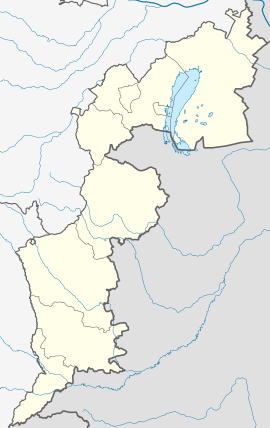Sankt Margarethen im Burgenland
Appearance
Sankt Margarethen im Burgenland | |
|---|---|
 Town hall | |
| Coordinates: 47°48′N 16°36′E / 47.800°N 16.600°E | |
| Country | Austria |
| State | Burgenland |
| District | Eisenstadt-Umgebung |
| Government | |
| • Mayor | Eduard Scheuhammer (ÖVP) |
| Area | |
• Total | 26.54 km2 (10.25 sq mi) |
| Elevation | 151 m (495 ft) |
| Population (2018-01-01)[2] | |
• Total | 2,636 |
| • Density | 99/km2 (260/sq mi) |
| Time zone | UTC+1 (CET) |
| • Summer (DST) | UTC+2 (CEST) |
| Postal code | 7062 |
| Website | www.st-margarethen.at |
Sankt Margarethen im Burgenland (Hungarian: Szentmargitbánya) is a town in Burgenland near the state capital of Eisenstadt, in Austria. It is home to a large 1st-century Roman quarry. A passion play has been presented in St Margarethen each summer for over seventy years. The town is close to the border with Hungary. The Pan-European Picnic peace demonstration was held near St. Margarethen in 1989 at the close of the Cold War.
Roman Quarry
[edit]The Roman Quarry has recently been transformed to cutting edge event venue. The architecture blends with the natural surroundings. A corten steel ramp makes the quarry accessible to all audiences.
Population
[edit]| Year | Pop. | ±% |
|---|---|---|
| 1869 | 1,911 | — |
| 1880 | 2,066 | +8.1% |
| 1890 | 2,197 | +6.3% |
| 1900 | 2,244 | +2.1% |
| 1910 | 2,141 | −4.6% |
| 1923 | 2,062 | −3.7% |
| 1934 | 2,307 | +11.9% |
| 1939 | 2,559 | +10.9% |
| 1951 | 2,268 | −11.4% |
| 1961 | 2,363 | +4.2% |
| 1971 | 2,546 | +7.7% |
| 1981 | 2,603 | +2.2% |
| 1991 | 2,608 | +0.2% |
| 2001 | 2,762 | +5.9% |
| 2011 | 2,732 | −1.1% |
| 2021 | 2,683 | −1.8% |
References
[edit]- ^ "Dauersiedlungsraum der Gemeinden Politischen Bezirke und Bundesländer - Gebietsstand 1.1.2018". Statistics Austria. Retrieved 10 March 2019.
- ^ "Einwohnerzahl 1.1.2018 nach Gemeinden mit Status, Gebietsstand 1.1.2018". Statistics Austria. Retrieved 9 March 2019.



